Lockdown in India changed many things about daily life, but one outlier trend that might just be here to stay is one of self-reliance and is an emerging space that savvy brands can capture, argues Grashima Sahni.
The advent of COVID-19 in India sparked significant trends on the back of a sudden change in consumer environments and their behaviour.
In the absence of a hard catalyst like the pandemic, Indian consumers would have taken at least a few more years to reach the current state. Most trends that leapfrogged into something big in this new normal, were at various nascent stages of adoption in pre-COVID India. Take for example digital media adoption, preference for video content, rise in digital payments, health consciousness, and even acceptance of e-learning – all had some level of existing traction in the Indian consumer’s life but has now become mainstream in a matter of weeks, if not days, during the lockdown.
One interesting behavioural change at the fringe of this accelerated change is that of self-reliance and self-dependence emerging in Indian consumers. It is a streak which was not strongly visible earlier, or at least prominent enough to be visible as a trend in the urban Indians before the forced lockdowns. Most basic household services even in middle-class Indian homes are outsourced i.e. cleaning and cooking, and basic salon services. This is owing to their extreme affordability, almost cheap if one compares prices to Western counterparts. But Covid-19 stripped all these comforts away, forcing a life of self-reliance.
A lot of product categories hence found traction with this enforcement.
A primary reason for this sudden traction in such categories is that the ‘buyers’ and ‘influencers’ of the product purchases in a household are now finally regularly interacting with these areas. The pain points are being understood first-hand during the prolonged lockdown after a long time, if not the first.
Most people are now spending increased time at home and expect this trend to mostly continue into the next year. Therefore, they are preparing themselves for a more comfortable self-reliant space at their homes.
Below are the top areas in a household where such product tractions can be observed. Please note that this trend-spotting, verified by trend searches and conversations on social media and not based real sales numbers.
1. Kitchen aids
While most Indian households are well stocked with basic kitchen appliances, the increased pressure of kitchen work and more meals at home, owing to safety concerns and availability of resources has led to a deepened need for more comfort. Consumers started indulging in various buys (or serious prospecting of such buys) which would help them ease the pressure of increased workload in the kitchen.
A quick look at the Google trends for dishwasher shows the increasing interest in the appliance since the lockdown.
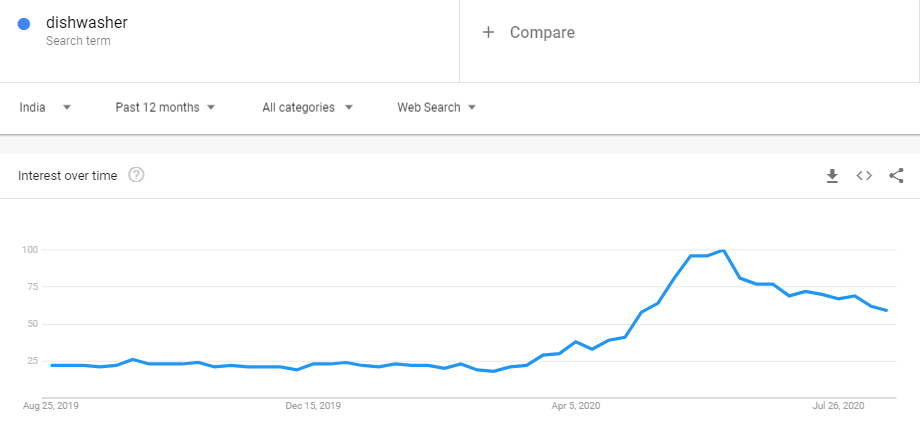
Source: Google Trends, India, Last 12 Months, Lockdown started in March in India
One can also see people asking for recommendations for quick buys in various specialised Facebook groups and communities. From dough makers to chopping equipment to even half-cooked rotis – Kitchen aids in Indian homes are finally getting mass upgrades this year.


Source: Screenshot from a Facebook Group
2. Cleaning equipment
With the house helps gone and the cleanliness requirements at the notch, everyone explored their collection of cleaning equipment and lead to a realisation of an upgrade they need. This YouTube influencer captures these pain points hilariously and on point – the broom and dust collector catch.
While we can see vacuum cleaners resurfacing as an interest (though the debate around whether they really work for Indian households and if they really save time or not continues), the clear trend here of interest is a slightly local but innovative product of a spin mop. A fair upgrade and innovation from the regular fully manual wet mopping, which requires no bending to the floor or manual twisting.
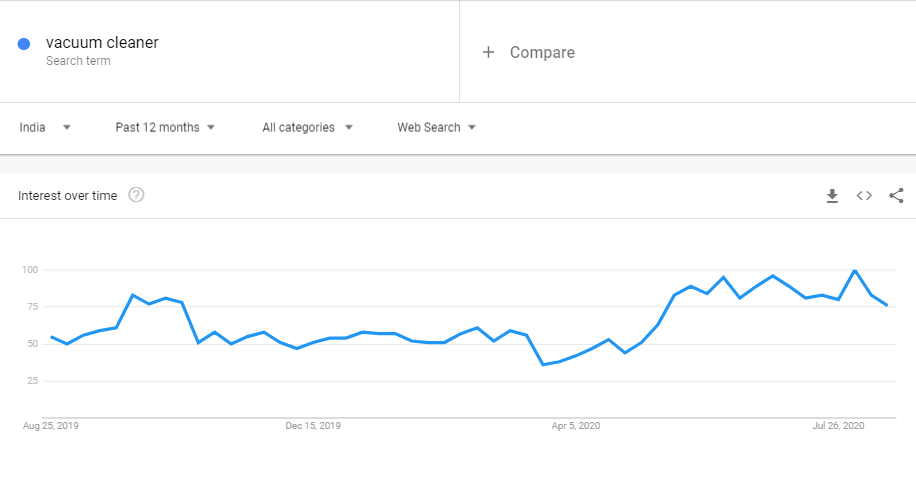
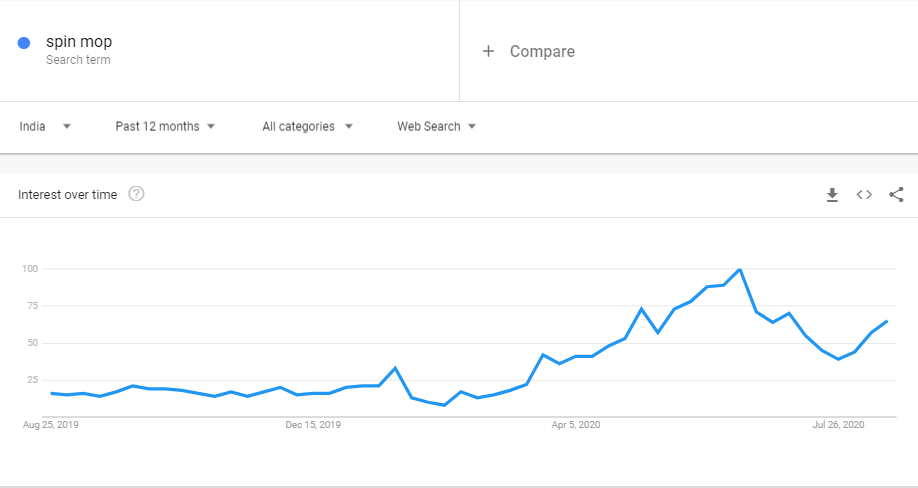
Source: Google Trends, India, Last 12 Months, Lockdown started in March in India
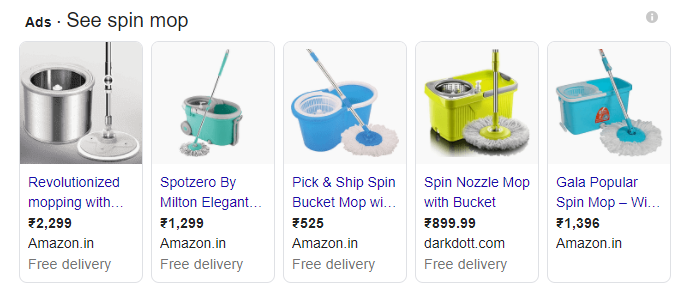
Source: Screenshot from Google search of spin mop
While the spin mop enjoyed a rise in interest, the pre-wet mopping space i.e. the broom and dustpan remain devoid of any major innovation. There’s space for a product which deals with this pressing point.
3. Female Grooming
Salon services in India have a wide affordability range. Beyond haircuts, the dependence on a salon for basic grooming needs for an average male is much lower than females in the same age bracket. Indian men have shaved at home for years, with trimmers having found high acceptance for male grooming use at home.
But with COVID-19 and parlours becoming a high-risk zone, women finally moved into DIY grooming at home in larger numbers. Epilator searches after the lockdown showed an increasing trend, reflecting a rising need for female grooming at home.
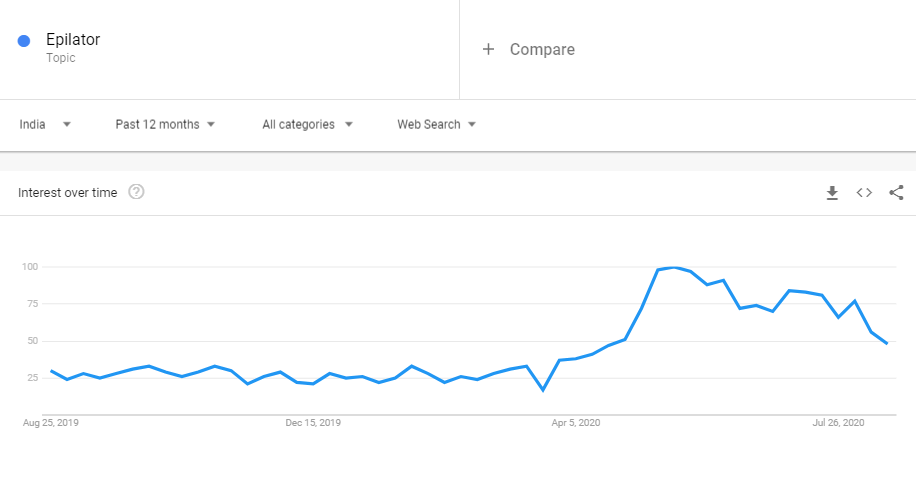
Source: Google Trends, India, Last 12 Months, Lockdown started in March in India
A dedicated collection on Amazon India also validates this trend:

The question now is whether these temporary breakouts or trends will stay and evolve further with time. The numbers are certain to go down, with many going back to pre-COVID habits when the easing of movement opens access to house help, service providers, and places of business such as salons open up again. But nothing can be said for certain and there’s a fair probability that sub-segments, where consumers find that their quality of life has indeed improved with self-sufficiency, will continue.
The individuals who stick with new habits formed during lockdown, are those who find and embrace independence in this self-sufficiency. A more informed guess would be that the workload at houses will help shape this trend of self-reliance. Individuals living in smaller households (most likely two or one) with a more balanced workload at home have a higher probability of continuing to dwell in this space.
The satisfaction of not being fully dependent on others for basic needs will continue to drive this segment and evolve it further.

